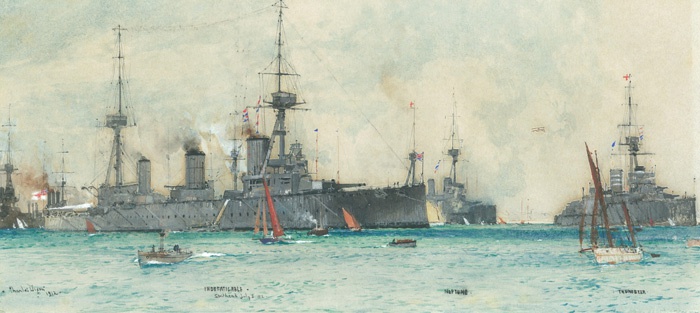HMS INDEFATIGABLE, HMS NEPTUNE AND HMS THUNDERER AT SPITHEAD, 8TH JULY 1912
(MP160). Charles Dixon RI (1872-1934). Watercolour. Signed, dated 1912, annotated "Spithead July 8th 1912" and with "INDEFATIGABLE", "NEPTUNE" and "THUNDERER" inscribed under each ship. A pair with MP 159.

Limited Edition: 25 copies worldwide
Standard size: 10.75 x 5ins (27 x 12.7 cms) approx but will easily enlarge.
Price band (standard size): £140-165
Charles Dixon at his finest: large warships of the very newest types, admirals flags and bunting afluttering, snowy white awnings spread, service boats on errands rushing importantly here and there and a plethora of small craft, sailing boats - and even a frail looking flying machine - filling the scene with bright, lively colours!
Spithead, the sea area immediately south of the great naval base of Portsmouth between the mainland and the Isle of Wight, has seen the Royal Navy’s warships come and go and gather at anchor for over 400 years. And here was another such gathering graced by none other than the Commander-in-Chief Home Fleets, Admiral Sir George Callaghan GCVO KCB wearing his flag at the main of the dreadnought HMS NEPTUNE (Captain A F Everett). In the anchorage also and to starboard of the C-in-C is HMS INDEFATIGABLE (Captain Arthur Leveson); and out ahead of NEPTUNE is another new dreadnought, HMS THUNDERER (Captain H F Oliver MVO). Commissioned only 3 weeks before this painting is dated THUNDERER had the distinction of being the last warship of any size to be built on the River Thames: and shortly after she was completed her builders, Thames IW, folded. The heavy tripod foremast astern of INDEFAT suggests another battle cruiser with an armoured cruiser or two in the background to the left; a further capital ship appears to be lying out on the far beam of INDEFAT.
HMS INDEFATIGABLE was part of Admiral Sir Archibald Berkley Milne’s Mediterranean Fleet when war broke out in 1914 and together with HMS INFLEXIBLE (Captain Richard Phillimore) and HMS INDOMITABLE (Captain Francis Kennedy), all members of the 2nd Battle Cruiser Squadron, participated in the famously ill-fated pursuit of Rear Admiral Wilhelm Souchon’s German force, the battle cruiser GOEBEN and her consort, the light cruiser BRESLAU. Returned from the Med by February 1915 she joined Admiral Beatty’s Battle Cruiser Force and was still part of the 2nd BCS when she went into action at Jutland. Matched against VON DER TANN (Captain Hans Zenker) a large explosion was seen to engulf INDEFAT who staggered out of line sinking by the stern before a second explosion finished her: she capsized quickly, and suddenly was no more. And of the others? Admiral Callaghan of NEPTUNE was famously removed from his post by the First Lord, Winston Churchill on the very eve of war in August 1914 being relieved by Admiral Jellicoe; NEPTUNE herself survived the war only to fall prey to the shipbreakers’ torch in 1922; and THUNDERER survived until 1926 when she managed to break free of her tow whilst enroute to the breakers, a last defiant stand by a proud battleship that was to be copied by other discarded dreadnoughts too, WARSPITE (in 1947) and VANGUARD (in 1960).